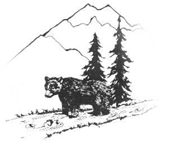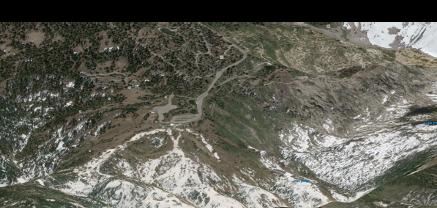
Bear Creek Association
Pre-Alpine Meadows History LessonRe-Printed with Permission by Andy Wertheim: March 17, 2015 Hello Skiers and Riders, I did not ski today, so I decided to lookback at the history of Alpine Meadows (prior name Bear Valley) before the ski area existed. Below is some information about the Deer Park Springs Hotel. This also gives us the history of some of our current street names in Alpine Meadows.
DEER PARK SPRINGS MOUNTAIN RESORTMany years before the Alpine Meadows Ski Area was developed the Deer Park Springs Hotel was constructed by John Brown Scott who owned land in Squaw Valley where he and his wife ran a successful dairy ranch that had been previously owned and operated by her first husband John P. Scott. In 1880 they completed construction of a 3 story 20 room hotel. 8 cabins were added with in the following 3 years. Across Bear Creek were iron, sulphur, and soda mineral springs which lured guests who bathed in them for health reasons. A social hall, stable, and barn were constructed to house horses and milk cows. The cabins had names such as “Forty Nine” named after the 49 steps leading to it pine entry door. In the 1890’s Scott would run a stage couch to Truckee where he picked up guests arriving by train from San Francisco. In 1900 a post office was established for the resort. In the same year a railroad station was constructed at the corner of Deer Park Road and the Truckee River where the new Lake Tahoe Railway from Truckee to Tahoe City would stop to drop off and pick up guests. Shortly after the turn of the century John Scott died and the resort was sold to Miss Katherine Chandler in 1905 a teacher of botany from San Francisco. She added tennis and croquet grounds to the resort. Other families owned the property in subsequent years, however in 1920 it was foreclosed upon by the San Francisco Board of Trade. After this the property went into a decaying state and was mostly lost to future travelers. John McNutt was the caretaker for the resort until 1909. Below is an interesting chapter from George Wharton James book “The Lake of the Sky” published in 1915 describing the resort. This was taken from the explorion.net website. Some the information above was taken from the Saga of Lake Tahoe authored by E.B.Scott in 1957. Part of the reason for writing this is to identify the street names in the current Alpine Meadows resort. I think these articles help us understand how the names of our streets were chosen. Mineral Spring Trail, Trapper McNutt, John Scott Trail, Deer Park, Old Barn, Bear Creek Drive, CHAPTER XIX. DEER PARK SPRINGSWhile in one sense all the resorts of the Tahoe region are mountain resorts, a difference should be noted between those that are located directly on the shores of Lake Tahoe, or some lesser lake, and those that are away from immediate proximity to a lake. The latter type is more correctly designated mountain resorts, and of these are three in the Tahoe region, viz., Deer Park Springs, Rubicon Springs and Glen Alpine. All these resorts were discovered by following the trails of animals which were visiting them for “salt licks” that existed in connection with their mineral waters as related in the chapter on Glen Alpine. Deer Park is a private estate of approximately 469 acres, in two sections, one the Mineral Springs Section, consisting of nearly 309 acres, and on which the celebrated springs – two of soda, one of sulphur, and one of iron – are located, and the other, the Five Lakes Section, of 160 acres. The former begins a mile from the Truckee River, up Bear Creek Canyon. This was originally taken up from the Government as timber claims, but the timber has never been cut, and the great pines, firs and junipers remain as the original settlers found them. The Five Lakes section is a fascinating and attractive location two miles away, over the first divide of the mountains, and therefore 1000 feet higher than the Inn, where five glacial lakes nestle in their granite basin. Four of these, and a large part of the fifth, are included in the estate, while all surrounding is government land of the Tahoe National Forest. If a dam were built to restrain the flow of water into Five Lake Creek, it would need only to be ten feet high to convert the five lakes into one, so near are they to the same level. As it is the flow from these lakes forms Five Lakes Creek, which empties into the Rubicon and thence into the South Fork of the American. Five Lakes afford excellent fishing and a log-cabin, three boats and fishing tackle are kept here throughout the season for the pleasure of guests. Those who disdain the ordinary accommodations of a hotel can here camp out, rough it, and make it their headquarters while climbing the adjoining peaks or exploring the ravines and canyons at the head of the American River. In 1914 a student from Stanford University was host at the Five Lakes log-cabin. He cooked for those who desired it, helped gather fir boughs for camp beds, prepared fishing-tackle for women anglers, rowed them to and fro over the lakes, and accompanied parties to the nearby summits. There are full accommodations at the cabin for seven persons, and the rule of the camp is that guests stay only one night, moving on to make room for the next comer, unless arrangements for a longer stay are made beforehand. Thus all the guests at Deer Park Inn may enjoy this novel experience if they so desire. In the region of Five Lakes, Basque and other foreign shepherds may be found tending their flocks, and prospectors, with queer little pack-burros, who climb the mountains seeking the elusive gold, as they did in the days of ’49. It was from Deer Park that the trail into the famous Hell Hole was recut by Miss Katherine Chandler, owner of the Inn and estate, in 1908, after having been lost for many years. Arrangements for this trip, and other famous hunting and fishing trips may be made at the Inn and many people who have gone over the mountains to the Yosemite have outfitted and secured their guide here. One of the finest trail trips of the Tahoe region is that afforded over the trail, back of Deer Park Inn, to the rugged pile known as The Crags, over Inspirational Ridge to Ward’s Peak. In the early part of the season great snow banks are encountered, and when the flowers begin to bloom there are great fields covered with Sierran primroses, with many patches of white heather and beautiful cyclamens.This is but one of many fine trail trips that may be made. Deer Park Inn is one of the oldest and best established resorts of the Tahoe region. The house that I occupied on my short visit was a solid log cabin, full of romantic interest, for it was quaint, old fashioned and appropriate to the surroundings. The key-note of the place is comfort. Under its present management a large number of wild New England flowers have been planted to add their beauty to that of the native California flower, and each year, about the third week in July, the guests wander over the sun-kissed slopes, climb the snowy heights and ramble through the shady woods gathering Sierran flowers of every hue, form and variety for an annual flower show. This is one of the distinctive features of the life at Deer Park Inn. It is an interesting fact here to notice that, when Miss Parsons, chief author of Flowers of California, was preparing that volume, she found such a wealth of mountain flora in the Deer Park region that she spent about as many weeks as she had planned for days. Other botanists have found it equally productive. To those who come early in the season tobogganing and snow shoeing are not unusual experiences. The shady sides of the mountains offer these winter sports as late as June and early July, and many Californians who have never enjoyed the frolic of snow-balling come here to gain their first experience in this common eastern enjoyment. Elsewhere I have referred to the many evidences of glacial action found about a mile above Deer Park Inn. Still further up the canyon, on the trail going to Five Lakes, are interesting deposits of volcanic rock – andeside – so that these two geological phenomena may be studied close at hand. Having its own rich meadows on Bear Creek, the Deer Park Spring tables are always supplied with good milk and cream from its own dairies, while fresh fruit and vegetables are supplied daily. Fish and game in season are frequent, and the table being under the direct and personal supervision of the management has gained an enviable reputation. Living water flows in marvelous abundance through Deer Park all throughout the year. Springs and melting snow send four different streams, tributary to Bear Creek, coursing across the property. The domestic water supply of the Inn is gained from springs on the mountain side, 800 feet above the Inn, and it is piped all over the place and to every cottage. There has been some talk, recently, of converting Deer Park into a private park. There is no better location for such a purpose in the whole Tahoe region. Situated as it is in the heart of a canyon it is readily isolated and thus kept entirely secluded and free from intrusion. While such a procedure would be a great advantage to any individual or club who might purchase the estate, it would be a decided loss to the general public who for so many years have enjoyed the charms and delights of this earliest of Sierran mountain resorts. Enjoy your day. |
